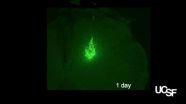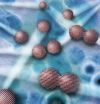However, patients were noted to have defects in B cell tolerance, meaning that some B cells that react to antigens from the body fail to be eliminated, leading to an autoimmune response. Dr. Eric Meffre and colleages at Yale University in New Haven, Connecticut and Alessandro Aiuti in Milan, Italy joined together to better understand why patients developed B cell tolerance problems. They found that loss of the ADA gene directly contributes to B cell tolerance problems and that these defects are mostly corrected after gene therapy. Their results point to a previously unknown role for ADA in B cell response and support the use of gene therapy as an effective treatment option for ADA-deficient severe combined immunodeficiency patients.
###
TITLE:
Defective B cell tolerance in adenosine deaminase deficiency is corrected by gene therapy
AUTHOR CONTACT:
Eric Meffre
Yale University School of Medicine, New Haven, CT, USA
Phone: 1-203-737-4535; Fax: 1-203-785-7903; E-mail: eric.meffre@yale.edu
ACCOMPANYING COMMENTARY
TITLE:
Restoring balance to B cells in ADA deficiency
AUTHOR CONTACT:
Eline Luning Prak
University of Pennsylvania, Philadelphia, PA, USA
Phone: 215 746 5768; E-mail: luning@mail.med.upenn.edu
Gene therapy can correct forms of severe combined immunodeficiency
2012-05-28
(Press-News.org) Severe combined immunodeficiency is defect in the immune system that results in a loss of the adaptive immune cells known as B cells and T cells. Mutations in several different genes can lead to the development of severe combined immunodeficiency, including mutation of the adenosine deaminase (ADA) gene. Traditional treatment options, such as enzyme replacement therapy, are of limited efficacy, but bone marrow transplant from a compatible donor leads to a better response. A recent clinical trial indicated that gene therapy to insert the correct ADA gene in the patient's own bone marrow cells can also lead to a good response.
ELSE PRESS RELEASES FROM THIS DATE:
A new strategy for developing meningitis vaccines
2012-05-28
Bacterial meningitis is an infection of the meninges, the protective membrane that covers the spinal cord and brain. Children, elderly patients and immunocompromised patients are at a higher risk for the development of severe bacterial meningitis. Recently, researchers at the University of Adelaide in Australia sought to identify new vaccine targets in Streptococcus pneumoniae, which is the most common cause of bacterial meningitis in the world. Led by Dr. Abiodun Ogunniyi, the research team developed a new method of screening for bacterial genes that are expressed during ...
Marked for destruction: Newly developed compound triggers cancer cell death
2012-05-28
The BCL-2 protein family plays a large role in determining whether cancer cells survive in response to therapy or undergo a form of cell death known as apoptosis. Cells are pressured toward apoptosis by expression of pro-apoptotic BCL-2 proteins. However, cancer cells respond to therapy by increasing expression of anti-apoptotic proteins, which bind and neutralize pro-apoptotic family members and mediate therapeutic resistance. Therefore, development of therapeutic strategies to neutralize resistance to apoptosis will be critical to clinical improvements.
A research group ...
JCI early table of contents for May 24, 2012
2012-05-28
GENE THERAPY
Gene therapy can correct forms of severe combined immunodeficiency
Severe combined immunodeficiency is defect in the immune system that results in a loss of the adaptive immune cells known as B cells and T cells. Mutations in several different genes can lead to the development of severe combined immunodeficiency, including mutation of the adenosine deaminase (ADA) gene. Traditional treatment options, such as enzyme replacement therapy, are of limited efficacy, but bone marrow transplant from a compatible donor leads to a better response. A recent clinical ...
A boost in microRNA may protect against sepsis and other inflammatory diseases
2012-05-28
BOSTON, MA—Acute inflammatory diseases, such as sepsis, as well as chronic inflammatory diseases like diabetes and arthritis, develop as a result of sustained inflammation of the blood vessel wall. Researchers at Brigham and Women's Hospital (BWH) have discovered that a microRNA (small, non-coding RNA molecule) called miR-181b can reduce the inflammatory response that is responsible for such diseases.
The findings, by researchers led by Mark Feinberg, MD from BWH and Harvard Medical School, will pave the way for new targets in the development of anti-inflammatory therapies. ...
Nuisance seaweed found to produce compounds with biomedical potential
2012-05-28
A seaweed considered a threat to the healthy growth of coral reefs in Hawaii may possess the ability to produce substances that could one day treat human diseases, a new study led by scientists at Scripps Institution of Oceanography at UC San Diego has revealed.
An analysis led by Hyukjae Choi, a postdoctoral researcher in William Gerwick's laboratory at Scripps, has shown that the seaweed, a tiny photosynthetic organism known as a "cyanobacterium," produces chemical compounds that exhibit promise as anti-inflammatory agents and in combatting bacterial infections. The ...
Chronic pain is relieved by cell transplantation in lab study
2012-05-28
Chronic pain, by definition, is difficult to manage, but a new study by UCSF scientists shows how a cell therapy might one day be used not only to quell some common types of persistent and difficult-to-treat pain, but also to cure the conditions that give rise to them.
The researchers, working with mice, focused on treating chronic pain that arises from nerve injury -- so-called neuropathic pain.
In their study, published in the March 24, 2012 issue of Neuron, the scientists transplanted immature embryonic nerve cells that arise in the brain during development and ...
Gourmet butterflies speed north
2012-05-28
A new study led by scientists in the Department of Biology at the University of York has shown how a butterfly has changed its diet, and consequently has sped northwards in response to climate change.
Their study is published in the latest issue of Science.
The researchers found that warmer summers have allowed the Brown Argus butterfly to complete its life cycle by eating wild Geranium plants. Because the Geraniums are widespread in the British countryside, this change in diet has allowed the butterfly to expand its range in Britain at a surprisingly rapid rate. Over ...
The cells' petrol pump is finally identified
2012-05-28
Our cells breathe and digest, as does the organism as a whole. They indeed use oxygen to draw the energy contained in the nutrients they ingest, before discarding the waste, as carbon dioxide and water. Glucose is a preferred nutrient for the cells. Its digestion occurs in the cytoplasm, in the absence of oxygen, and leads to the formation of pyruvate and a small amount of energy. Pyruvate is then carried into mitochondria, the cell's power plants, for a complete burning, thus providing a maximal energetic yield.
A mediocre energetic yield in tumor cells
'As opposed ...
CWRU class earns Science magazine prize for innovation
2012-05-28
Science magazine has awarded a prize for Inquiry-Based Instruction to a Case Western Reserve University class that melds biology, computer modeling, mathematical analysis and writing.
"Dynamics of Biological Systems," taught by Biology Professor Hillel Chiel and three graduate assistants, abandons traditional lectures altogether in favor of learning by doing. The teachers call the class an example of the use of the continual improvement model in education.
In it, Chiel pairs biology majors with engineering, physics or math majors, and has them concentrate on building ...
First direct observation of oriented attachment in nanocrystal growth
2012-05-28
Through biomineralization, nature is able to produce such engineering marvels as mother of pearl, or nacre, the inner lining of abalone shells renowned for both its iridescent beauty and amazing toughness. Key to biomineralization is the phenomenon known as "oriented attachment," whereby adjacent nanoparticles connect with one another in a common crystallographic orientation. While the importance of oriented attachment to biomineral properties long has been recognized, the mechanism by which it occurs has remained a mystery. With a better understanding of oriented attachment ...

